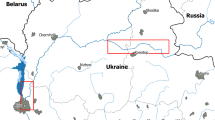Abstract
Relevés of Isoetid vegetation from 60 lakes in southern Sweden have been classified with the help on numerical methods. A community system is constructed, at the variant level by clustering with the TABORD program, and at the community and subcommunity levels by reference to traditional floristic characteristics. The diagnostic species were selected with the help of PCA. Isoëtes lacustris, Lobelia dortmanna and Littorella uniflora determined the community composition together with Eleocharis acicularis. The differentation of the syntaxa along the first three ordination axes of a PCA was clear. The complex water depth factor determines clearly the position of the small syntaxa (variants) in the PCA ordination space. At high levels of similarity the relevés were grouped effectively with the TABORD program, so that the clusters are floristically homogeneous and easy to identify on the basis of floristicsociological criteria. At higher syntaxon levels a selective use of diagnostic species was made.
Similar content being viewed by others
References
Abbott, L.A., Bisby, F.A. & Rogers, D.J. 1985. Taxonomic analysis in biology. Columbia University Press, New York.
Albertson, N. 1950. Das grosse südliche Alvar der Insel Öland. Eine pflanzensoziologische übersicht. Svensk Bot. Tidsskr. 44: 269–331.
Andersson, P.-A. 1988. Ordination and classification of operational geographic units in Southwest Sweden. Vegetatio 74: 95–106.
Barkman, J.J., Moravec, J. & Rauschert, S. 1986. Code of phytosociological nomenclature. 2nd ed. Vegetatio 67: 145–195.
Beals, E.W. 1984. Bray-Curtis ordination: an effective strategy for analysis of multivariate ecological data. Adv. Ecol. Res. 14: 1–55.
Braun-Blanquet, J. 1964. Pflanzensoziologie, Grundlagen der Vegetationskunde. 3. Aufl. Spring Verlag. Wien, New York.
Carleton, T.J. 1980. Non-centred component analysis of vegetation data: a comparison of orthogonal and oblique rotation. Vegetatio 42: 59–66.
Dale, M.B. & Webb, L.J. 1975. Numerical methods for the establishment of associations. Vegetatio 30: 77–87.
Dale, M.B. & Williams, W.I. 1978. A new method of species reduction for ecological data. Austr. J. Ecol. 3: 1–5.
Dierssen, K. 1975. Littorelletea uniflorae Br-Bl. et Tw. 1943. J. Cramer, Vaduz.
Downing, J.A. & Anderson, M.R. 1985. Estimating the standing biomass of aquatic macrophytes. Can. J. Fish. Aquat. Sci. 42: 1860–1869.
Du Rietz, G.E. & Hannerz, A.G. 1939. Gefässpflanzenvegetation. In: Du Rietz, G.E., Hannerz, A.G., Lohammar, G., Santesson, R. & Wärn, M. Zur Kenntnis der Vegetation des Sees Tåkern. Acta Phytogeogr. Suec. 12: 1–41.
Ellenberg, H. 1956. Aufgaben und Methoden der Vegetationskunde. In: Walter, H. (ed.) Einführung in die Phytologie IV. Grundlagen der Vegetationsgliederung 1: 1–136. Eugen Ulmer, Stuttgart.
Jensén, S. 1978. Influences of transformation of cover values on classification and ordination of lake vegetation. Vegetatio 34: 19–31.
Jensén, S. 1979. Classification of lakes in Southern Sweden on the basis of their macrophyte composition by means of multivariate methods. Vegetatio 39: 129–146.
Jensén, S. & van der Maarel, E. 1980. Numerical approaches to lake classification with special reference to macrophyte communities. Vegetatio 42: 117–128.
Kissling, P., Kuhn, N. & Wildi, O. 1988. The merocoenotic sample and its use in investigating floristic changes in forests. Bot. Helv. 98: 39–75.
Klokk, T. 1981. Classification and ordination of river bank vegetation from middle and upper parts of the river Gaula, Central Norway. K. Norske Vidensk. Selsk. Skr. 1980 (2): 1–43.
Krahulec, F., Rosén, E. & van der Maarel, E. 1986. Preliminary classification and ecology of dry grassland communities on Ölands Stora Alvar (Sweden). Nord. J. Bot 6: 797–809.
Lohammar, G. 1938. Wasserchemie und höhere Vegetation schwedischer Seen. Symb. Bot. Ups. 3 (1): 1–252.
Magnusson, N.H. et al. 1957. Karta över Sveriges berggrund. Pre-Quaternary rocks of Sweden. Utarbetad vid Sveriges Geologiska Undersökning 1957. Skala 1 :1000 000. Stockholm.
Mäkirinta, U. 1978a Die pflanzensoziologische Gliederung der Wasservegetation im See Kukkia, Südfinnland. Acta Univ. Oulu A 75: 1–157.
Mäkirinta, U. 1978b. Ein neues ökomorphologisches Lebenformensystem der aquatischen Makrophyten. Phytocoenologia 4: 446–470.
Mäkirinta, U. 1985. Classification and ecology of the Isoetid vegetation of lakes in Southern Sweden. In: Hytteborn, H. van der Maarel, E. & Wallström, K. (eds), Research in Progress at the Institute of Ecological Botany, Uppsala University 1982–84. Medd. Växtbiol. Inst., Uppsala, 1985 (1): 55.
Mäkirinta, U. 1986. Vegetation types and exposure on acid rocks in South Häme, South Finland. Coll. Phytosoc. 13: 469–484.
Maristo, L. 1941. Die Seetypen Finnlands auf floristischer und vegetationsfysiognomischer Grundlage. Ann. Bot. Soc. Vanamo 6 (4): 1–55.
Pietsch, W. 1977. Beitrag zur Soziologie und Ökologie der europäischen Littorelletea- und Utricularietea-Gesellschaften. Feddes Repert. 88: 141–245.
Popma, J., Mucina, L., van Tongeren, O. & van der Maarel, E. 1983. On the determination of optimal levels in phytosociological classification. Vegetatio 52: 65–75.
Raspopov, I.M. 1971. Makrofiti Onezkogo ozera. In: Raspopov, I.M. (ed.), Rastitel'nyi mir' Onezhskogo ozera: 21–87. Izd. Akad. Nauk SSSR, Leningrad.
Roskam, E. 1971. Program ORDINA: Multidimensional ordination of observation vectors. Progr. Bull. Psych. Lab. Nijmegen 16: 1–8.
Stålberg, N. 1939. Lake Vättern. Outlines of its natural history, especially its vegetation. Acta Phytogeogr. Suec. 11: 1–52.
Thunmark, S. 1931. Der See Fiolen und seine Vegetation Acta Phytogeogr. Suec. 2: 1–198.
Tüxen, R. 1937. Die Pflanzengesellschaften Nordwestdeutschlands. Mitt. Florist.-soziol. Arbeitsgem. Niedersachsen 3: 1–170.
Vaarama, A. 1938. Wasservegetationsstudien am Grossee Kallavesi. Ann. Bot. Soc. Vanamo 13 (1) 1–318.
van der Maarel, E. 1979. Transformation of cover-abundance values in phytosociology and its effects on community similarity. Vegetatio 39: 97–114.
van der Maarel, E. 1980. On the interpretability of ordination diagrams. Vegetatio 42: 43–45.
van der Maarel, E. 1982. On the manipulation and editing of phytosociological and ecological data. Vegetatio 50: 71–76.
van der Maarel, E., Janssen, J. & Louppen, J. 1978. TABORD, a program for structuring phytosociological tables. Vegetatio 38: 143–156.
Westhoff, V. & van der Maarel, E. 1978. the Braun-Blanquet approach. In: Whittaker, R.H. (ed.) Classification of plant communities: 287–399. Junk, The Hague.
Author information
Authors and Affiliations
Rights and permissions
About this article
Cite this article
Mäkirinta, U. Classification of South Swedish Isoetid vegetation with the help of numerical methods. Vegetatio 81, 145–157 (1989). https://doi.org/10.1007/BF00045520
Accepted:
Issue Date:
DOI: https://doi.org/10.1007/BF00045520




